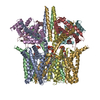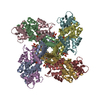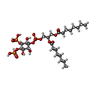+ Open data
Open data
- Basic information
Basic information
| Entry |  | |||||||||
|---|---|---|---|---|---|---|---|---|---|---|
| Title | Human KCNQ5-CaM-PIP2-HN37 complex in a closed conformation. | |||||||||
 Map data Map data | ||||||||||
 Sample Sample |
| |||||||||
 Keywords Keywords | voltage-gated potassium channel / MEMBRANE PROTEIN | |||||||||
| Function / homology |  Function and homology information Function and homology informationclathrin coat / transporter inhibitor activity / voltage-gated monoatomic ion channel activity involved in regulation of presynaptic membrane potential / Voltage gated Potassium channels / establishment of protein localization to mitochondrial membrane / type 3 metabotropic glutamate receptor binding / response to corticosterone / negative regulation of high voltage-gated calcium channel activity / negative regulation of calcium ion export across plasma membrane / regulation of cardiac muscle cell action potential ...clathrin coat / transporter inhibitor activity / voltage-gated monoatomic ion channel activity involved in regulation of presynaptic membrane potential / Voltage gated Potassium channels / establishment of protein localization to mitochondrial membrane / type 3 metabotropic glutamate receptor binding / response to corticosterone / negative regulation of high voltage-gated calcium channel activity / negative regulation of calcium ion export across plasma membrane / regulation of cardiac muscle cell action potential / presynaptic endocytosis / nitric-oxide synthase binding / regulation of synaptic vesicle exocytosis / regulation of cell communication by electrical coupling involved in cardiac conduction / calcineurin-mediated signaling / adenylate cyclase binding / protein phosphatase activator activity / voltage-gated potassium channel activity / catalytic complex / detection of calcium ion / regulation of synaptic vesicle endocytosis / regulation of cardiac muscle contraction / postsynaptic cytosol / regulation of cardiac muscle contraction by regulation of the release of sequestered calcium ion / phosphatidylinositol 3-kinase binding / presynaptic cytosol / regulation of release of sequestered calcium ion into cytosol by sarcoplasmic reticulum / titin binding / sperm midpiece / regulation of calcium-mediated signaling / voltage-gated potassium channel complex / potassium ion transmembrane transport / calcium channel complex / substantia nigra development / regulation of heart rate / calyx of Held / response to amphetamine / adenylate cyclase activator activity / sarcomere / nitric-oxide synthase regulator activity / protein serine/threonine kinase activator activity / regulation of cytokinesis / spindle microtubule / calcium channel regulator activity / response to calcium ion / mitochondrial membrane / G2/M transition of mitotic cell cycle / Schaffer collateral - CA1 synapse / long-term synaptic potentiation / spindle pole / calcium-dependent protein binding / synaptic vesicle membrane / myelin sheath / presynaptic membrane / growth cone / vesicle / transmembrane transporter binding / G protein-coupled receptor signaling pathway / protein domain specific binding / calcium ion binding / centrosome / protein kinase binding / protein-containing complex / nucleus / plasma membrane / cytoplasm Similarity search - Function | |||||||||
| Biological species |  Homo sapiens (human) Homo sapiens (human) | |||||||||
| Method | single particle reconstruction / cryo EM / Resolution: 3.2 Å | |||||||||
 Authors Authors | Yang Z / Guo J | |||||||||
| Funding support |  China, 1 items China, 1 items
| |||||||||
 Citation Citation |  Journal: Proc Natl Acad Sci U S A / Year: 2025 Journal: Proc Natl Acad Sci U S A / Year: 2025Title: Phosphatidylinositol 4,5-bisphosphate activation mechanism of human KCNQ5. Authors: Zhenni Yang / Yueming Zheng / Demin Ma / Long Wang / Jiatong Zhang / Tiefeng Song / Yong Wang / Yan Zhang / Fajun Nan / Nannan Su / Zhaobing Gao / Jiangtao Guo /  Abstract: The human voltage-gated potassium channels KCNQ2, KCNQ3, and KCNQ5 can form homo- and heterotetrameric channels that are responsible for generating the neuronal M current and maintaining the membrane ...The human voltage-gated potassium channels KCNQ2, KCNQ3, and KCNQ5 can form homo- and heterotetrameric channels that are responsible for generating the neuronal M current and maintaining the membrane potential stable. Activation of KCNQ channels requires both the depolarization of membrane potential and phosphatidylinositol 4,5-bisphosphate (PIP). Here, we report cryoelectron microscopy structures of the human KCNQ5-calmodulin (CaM) complex in the apo, PIP-bound, and both PIP- and the activator HN37-bound states in either a closed or an open conformation. In the closed conformation, a PIP molecule binds in the middle of the groove between two adjacent voltage-sensing domains (VSDs), whereas in the open conformation, one additional PIP binds to the interface of VSD and the pore domain, accompanying structural rearrangement of the cytosolic domain of KCNQ and CaM. The structures, along with electrophysiology analyses, reveal the two different binding modes of PIP and elucidate the PIP activation mechanism of KCNQ5. | |||||||||
| History |
|
- Structure visualization
Structure visualization
| Supplemental images |
|---|
- Downloads & links
Downloads & links
-EMDB archive
| Map data |  emd_63130.map.gz emd_63130.map.gz | 48.3 MB |  EMDB map data format EMDB map data format | |
|---|---|---|---|---|
| Header (meta data) |  emd-63130-v30.xml emd-63130-v30.xml emd-63130.xml emd-63130.xml | 18.9 KB 18.9 KB | Display Display |  EMDB header EMDB header |
| Images |  emd_63130.png emd_63130.png | 134.4 KB | ||
| Filedesc metadata |  emd-63130.cif.gz emd-63130.cif.gz | 6.4 KB | ||
| Others |  emd_63130_half_map_1.map.gz emd_63130_half_map_1.map.gz emd_63130_half_map_2.map.gz emd_63130_half_map_2.map.gz | 46.1 MB 46.2 MB | ||
| Archive directory |  http://ftp.pdbj.org/pub/emdb/structures/EMD-63130 http://ftp.pdbj.org/pub/emdb/structures/EMD-63130 ftp://ftp.pdbj.org/pub/emdb/structures/EMD-63130 ftp://ftp.pdbj.org/pub/emdb/structures/EMD-63130 | HTTPS FTP |
-Validation report
| Summary document |  emd_63130_validation.pdf.gz emd_63130_validation.pdf.gz | 821.7 KB | Display |  EMDB validaton report EMDB validaton report |
|---|---|---|---|---|
| Full document |  emd_63130_full_validation.pdf.gz emd_63130_full_validation.pdf.gz | 821.3 KB | Display | |
| Data in XML |  emd_63130_validation.xml.gz emd_63130_validation.xml.gz | 11.8 KB | Display | |
| Data in CIF |  emd_63130_validation.cif.gz emd_63130_validation.cif.gz | 13.9 KB | Display | |
| Arichive directory |  https://ftp.pdbj.org/pub/emdb/validation_reports/EMD-63130 https://ftp.pdbj.org/pub/emdb/validation_reports/EMD-63130 ftp://ftp.pdbj.org/pub/emdb/validation_reports/EMD-63130 ftp://ftp.pdbj.org/pub/emdb/validation_reports/EMD-63130 | HTTPS FTP |
-Related structure data
| Related structure data |  9lj1MC  9j38C  9lizC  9lj5C M: atomic model generated by this map C: citing same article ( |
|---|---|
| Similar structure data | Similarity search - Function & homology  F&H Search F&H Search |
- Links
Links
| EMDB pages |  EMDB (EBI/PDBe) / EMDB (EBI/PDBe) /  EMDataResource EMDataResource |
|---|
- Map
Map
| File |  Download / File: emd_63130.map.gz / Format: CCP4 / Size: 52.7 MB / Type: IMAGE STORED AS FLOATING POINT NUMBER (4 BYTES) Download / File: emd_63130.map.gz / Format: CCP4 / Size: 52.7 MB / Type: IMAGE STORED AS FLOATING POINT NUMBER (4 BYTES) | ||||||||||||||||||||||||||||||||||||
|---|---|---|---|---|---|---|---|---|---|---|---|---|---|---|---|---|---|---|---|---|---|---|---|---|---|---|---|---|---|---|---|---|---|---|---|---|---|
| Projections & slices | Image control
Images are generated by Spider. | ||||||||||||||||||||||||||||||||||||
| Voxel size | X=Y=Z: 0.93 Å | ||||||||||||||||||||||||||||||||||||
| Density |
| ||||||||||||||||||||||||||||||||||||
| Symmetry | Space group: 1 | ||||||||||||||||||||||||||||||||||||
| Details | EMDB XML:
|
-Supplemental data
-Half map: #1
| File | emd_63130_half_map_1.map | ||||||||||||
|---|---|---|---|---|---|---|---|---|---|---|---|---|---|
| Projections & Slices |
| ||||||||||||
| Density Histograms |
-Half map: #2
| File | emd_63130_half_map_2.map | ||||||||||||
|---|---|---|---|---|---|---|---|---|---|---|---|---|---|
| Projections & Slices |
| ||||||||||||
| Density Histograms |
- Sample components
Sample components
-Entire : Human KCNQ5-CaM-PIP2-HN37 complex
| Entire | Name: Human KCNQ5-CaM-PIP2-HN37 complex |
|---|---|
| Components |
|
-Supramolecule #1: Human KCNQ5-CaM-PIP2-HN37 complex
| Supramolecule | Name: Human KCNQ5-CaM-PIP2-HN37 complex / type: complex / ID: 1 / Parent: 0 / Macromolecule list: #1-#2 |
|---|---|
| Source (natural) | Organism:  Homo sapiens (human) Homo sapiens (human) |
-Macromolecule #1: Potassium voltage-gated channel subfamily KQT member 5
| Macromolecule | Name: Potassium voltage-gated channel subfamily KQT member 5 type: protein_or_peptide / ID: 1 / Number of copies: 4 / Enantiomer: LEVO |
|---|---|
| Source (natural) | Organism:  Homo sapiens (human) Homo sapiens (human) |
| Molecular weight | Theoretical: 70.463289 KDa |
| Recombinant expression | Organism:  Homo sapiens (human) Homo sapiens (human) |
| Sequence | String: MLGKPLSYTS SQSCRRNVKY RRVQNYLYNV LERPRGWAFI YHAFVFLLVF GCLILSVFST IPEHTKLASS CLLILEFVMI VVFGLEFII RIWSAGCCCR YRGWQGRLRF ARKPFCVIDT IVLIASIAVV SAKTQGNIFA TSALRSLRFL QILRMVRMDR R GGTWKLLG ...String: MLGKPLSYTS SQSCRRNVKY RRVQNYLYNV LERPRGWAFI YHAFVFLLVF GCLILSVFST IPEHTKLASS CLLILEFVMI VVFGLEFII RIWSAGCCCR YRGWQGRLRF ARKPFCVIDT IVLIASIAVV SAKTQGNIFA TSALRSLRFL QILRMVRMDR R GGTWKLLG SVVYAHSKEL ITAWYIGFLV LIFSSFLVYL VEKDANKEFS TYADALWWGT ITLTTIGYGD KTPLTWLGRL LS AGFALLG ISFFALPAGI LGSGFALKVQ EQHRQKHFEK RRNPAANLIQ CVWRSYAADE KSVSIATWKP HLKALHTCSP TKK EQGEAS SSQKLSFKER VRMASPRGQS IKSRQASVGD RRSPSTDITA EGSPTKVQKS WSFNDRTRFR PSLRLKSSQP KPVI DADTA LGTDDVYDEK GCQCDVSVED LTPPLKTVIR AIRIMKFHVA KRKFKETLRP YDVKDVIEQY SAGHLDMLCR IKSLQ TRVD QILGKGQITS DKKSREKITA EHETTDDLSM LGRVVKVEKQ VQSIESKLDC LLDIYQQVLR KGSASALALA SFQIPP FEC EQTSDYQSPV DSKDLSGSAQ NSGCLSRSTS ANISRGLQFI LTPNEFSLEG GSSGGWSHPQ FEK UniProtKB: Potassium voltage-gated channel subfamily KQT member 5 |
-Macromolecule #2: Calmodulin-3
| Macromolecule | Name: Calmodulin-3 / type: protein_or_peptide / ID: 2 / Number of copies: 4 / Enantiomer: LEVO |
|---|---|
| Source (natural) | Organism:  Homo sapiens (human) Homo sapiens (human) |
| Molecular weight | Theoretical: 19.615445 KDa |
| Recombinant expression | Organism:  Homo sapiens (human) Homo sapiens (human) |
| Sequence | String: MADQLTEEQI AEFKEAFSLF DKDGDGTITT KELGTVMRSL GQNPTEAELQ DMINEVDADG NGTIDFPEFL TMMARKMKDT DSEEEIREA FRVFDKDGNG YISAAELRHV MTNLGEKLTD EEVDEMIREA DIDGDGQVNY EEFVQMMTAK LEGGSSGGLV P RGSGGSSG GHHHHHHHH UniProtKB: Calmodulin-3 |
-Macromolecule #3: methyl N-[4-[(4-fluorophenyl)methyl-prop-2-ynyl-amino]-2,6-dimeth...
| Macromolecule | Name: methyl N-[4-[(4-fluorophenyl)methyl-prop-2-ynyl-amino]-2,6-dimethyl-phenyl]carbamate type: ligand / ID: 3 / Number of copies: 4 / Formula: 9MF |
|---|---|
| Molecular weight | Theoretical: 340.391 Da |
| Chemical component information |  ChemComp-9MF: |
-Macromolecule #4: [(2R)-2-octanoyloxy-3-[oxidanyl-[(1R,2R,3S,4R,5R,6S)-2,3,6-tris(o...
| Macromolecule | Name: [(2R)-2-octanoyloxy-3-[oxidanyl-[(1R,2R,3S,4R,5R,6S)-2,3,6-tris(oxidanyl)-4,5-diphosphonooxy-cyclohexyl]oxy-phosphoryl]oxy-propyl] octanoate type: ligand / ID: 4 / Number of copies: 4 / Formula: PIO |
|---|---|
| Molecular weight | Theoretical: 746.566 Da |
| Chemical component information |  ChemComp-PIO: |
-Experimental details
-Structure determination
| Method | cryo EM |
|---|---|
 Processing Processing | single particle reconstruction |
| Aggregation state | particle |
- Sample preparation
Sample preparation
| Buffer | pH: 8 |
|---|---|
| Vitrification | Cryogen name: ETHANE |
- Electron microscopy
Electron microscopy
| Microscope | TFS KRIOS |
|---|---|
| Image recording | Film or detector model: GATAN K2 QUANTUM (4k x 4k) / Average electron dose: 52.0 e/Å2 |
| Electron beam | Acceleration voltage: 300 kV / Electron source:  FIELD EMISSION GUN FIELD EMISSION GUN |
| Electron optics | Illumination mode: FLOOD BEAM / Imaging mode: BRIGHT FIELD / Cs: 2.7 mm / Nominal defocus max: 1.6 µm / Nominal defocus min: 0.8 µm |
| Experimental equipment |  Model: Titan Krios / Image courtesy: FEI Company |
 Movie
Movie Controller
Controller







 Z (Sec.)
Z (Sec.) Y (Row.)
Y (Row.) X (Col.)
X (Col.)




































